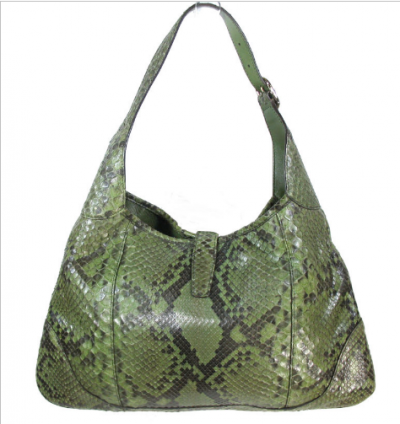|

We live in a society dominated by consumerism. Our European and American and Asian affluent societies like to drape and drip and swathe and adorn and decorate and thereby show off a huge diversity of animal products, ranging from claws to capes, piano keys to statuettes to pendants, wallets and bags to wall hangings and rugs – oh, and even trophy rooms! It is all for sale.
Aggressive advertising and the show-off factor contribute to people buying, for example, bags and wallets and shoes and clothing made from crocodile, snake, elephant – and yes, even leopard, lion, tiger, jaguar, clouded leopard, fox and seal skins. With demand booming, major fashion houses like Gucci and others like Hermès, LVMH and Kering have rushed to buy snake and crocodile “farms” to supply their skins. In 2014 alone Italy imported well over 1,320,000 snake, crocodile and lizard skins and it would seem that the python skin trade alone is worth $1 billion annually. Most of these python skins seem illegally harvested from the wild as there are not really any believable “snake farms” - snakes take too long to mature and are too expensive to rear in captivity .
I could go on and on listing all the other animal products our consumer society demands and is sold. How about walrus ivory? No problem, perhaps worth $50,000 for a pair of tusks. Narwhal ivory? Fetches $30,000 per “tusk” . All available in shops and on ebay of course. Want a tatty lion head mount? Look no further than here:
Wildlife consumers and sellers often hide behind legitimacy – all the narwhals were killed legitimately by Inuits, the American bear skins were provided by “sustainable trappers”, and the ivory we buy in European and American shops is all “old” ivory. Right?
Wrong.
Time and again, those who take the trouble to investigate show the “legal” products we buy are invaded by the illegal. A recent BBC documentary showed how ludicrously easy it is to buy illegal ivory in Hong Kong and the UK. Karl Ammann continuously investigates the open markets in illegal wildlife trade in Asia and is always able to show high levels of illegal sales activity under the noses of “enforcement” officials.
In the path of all this consumerism stand a number of NGOs attempting to reduce such greed (especially for ivory and rhino horn) in various Asian countries. Demand reduction campaigns have been in place for some time, and some report successes. Others in the demand reduction sphere say the campaigns are not effective as they are not using the right messages and that the campaigns need significant fine tuning, learning about consumers and making needed adjustments at every step of the way. Both Dr Lynn Johnson of Breaking the Brand and Karl Ammann are critical of present demand reduction campaigns, suggesting that they could be much more successful by being more innovative. Many of these campaigns rely on advertising, and there is little experience among advertising companies (always promoting consumerism) on how to run an effective “negative” campaign – and such negatives are often not allowed in Asian consumer countries. In addition, it is very difficult to assess the “success” of demand reduction campaigns as the “results” are often based on anecdotal and subjective data. And meanwhile there seems to be no reduction in the slaughter of the animals providing the products on sale.
Clearly, the entire concept of “sustainable trade” in animal products needs to be revised. Demand reduction campaigns seem overall not to be really changing hearts and minds of fixated consumers and their crassly commercial suppliers. Supply chains that claim to be using legal and “sustainable” sources have generally been shown to be porous to illegal products because there is not the enforcement capability nor the political will to reduce illegal trading.
Consumers are diffuse, but shopkeepers and sellers are readily identified even via internet options.
There really seems only one effective way forward and that is to strictly legislate against any further sales of very many wildlife products. Perhaps a new slogan is needed – when the selling is stopped the buying will too.
Picture credit: http://www.citidine.com/redtag/images/gucci_greensnakeskin2.jpg
|




